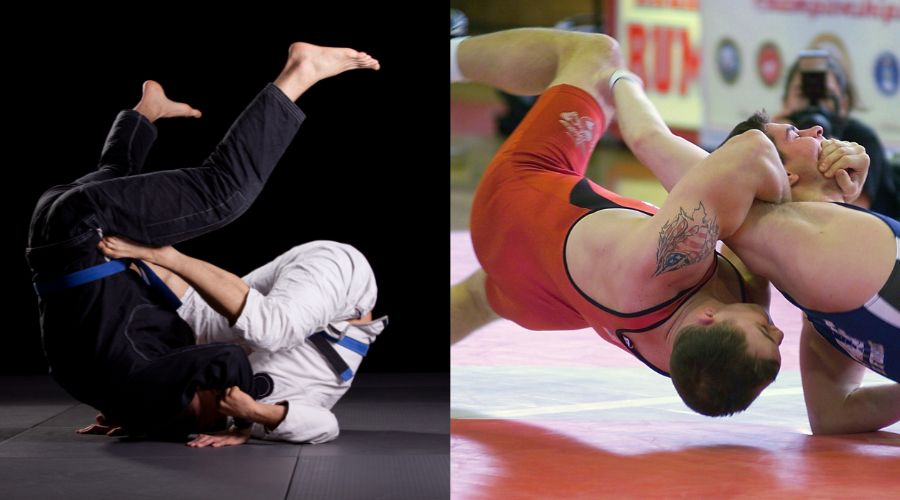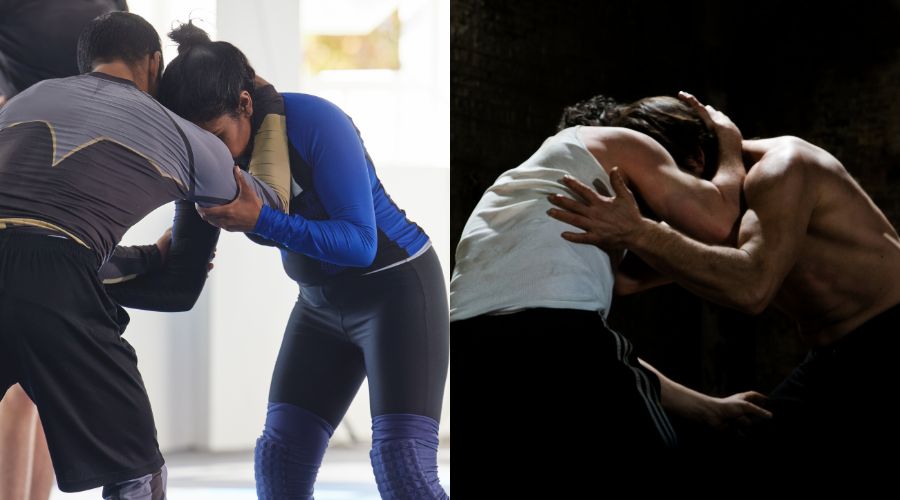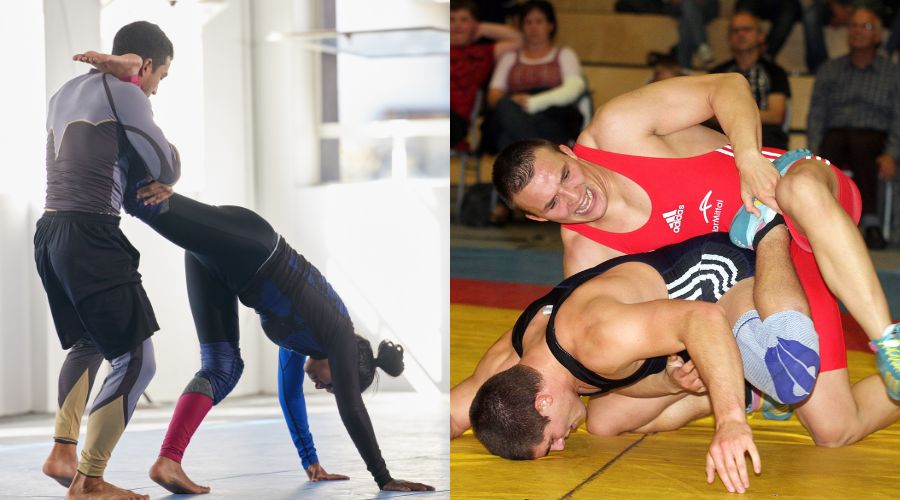Grappling has many forms worldwide, and Brazilian Jiu-Jitsu and catch wrestling are two of the most prominent submission-based styles. With rich histories behind both, they enrich the other in today’s world of submission grappling competitions. But what is the difference between them?
Both BJJ and catch wrestling are submission-based grappling martial arts. Brazilian Jiu-Jitsu is a more technical and gentle approach to submission grappling, emphasizing positioning. Catch wrestling is a more aggressive and fast-paced martial art with the end goal of pinning or submitting the opponent through pain and pressure.
The increasing number of practitioners and the submission grappling tournaments bringing grapplers from all styles together blur the boundaries between styles. However, some fundamental differences between BJJ and catch wrestling are still worth knowing.
What Is BJJ
Brazilian Jiu-Jitsu is a grappling martial art created for self-defense that has evolved into a separate sport and an integral part of mixed martial arts.
BJJ is a grappling system employing a methodical and tactical approach to submit an opponent via choke or joint lock. The main principles of BJJ are leverage, technique, and precision.
BJJ was created in Brazil out of traditional jiu-jitsu and judo taught by Japanese master Mitsuyo Maeda to the Gracie family in Brazil. The Gracie brothers focused more on the ground portion of the fight.
They developed it into a style of their own, allowing smaller people to defeat bigger and stronger opponents through technique and leverage.
BJJ was tested and evolved through countless no-rules matches in Brazil, but it came to prominence in the 1990s with the advent of the UFC. Royce Gracie won three of the first four events and paved the way for the worldwide popularity of jiu-jitsu.
Today, the style is extremely popular, practiced by millions worldwide as a self-defense system, a grappling-only sport, and part of MMA.
What Is Catch Wrestling
Catch wrestling is a grappling style focused on fast-paced, aggressive submission wrestling. The end goal is a pin or a submission; the main methods of achieving them are pressure, pain, and technique. Submission holds are called hooks in catch wrestling.
The true origins of catch wrestling are, in all likelihood, rooted in very deep antiquity. Still, we can track it to the late 1800s in England. Miners and iron workers used to wrestle for fun or small bets after work.
English sailors who traveled the world brought back new techniques and further enriched the wrestling style of the time known as “catch-as-catch,” which can be translated as “catch me if you can” or “catch what you can.”
The style was commonly showcased at carnivals and fairs, where wrestlers would meet challengers for bets. The variety of opponents meant catch wrestlers had to be prepared for anything and always go for quick and aggressive submissions, which were the most straightforward way to win.
Catch wrestling is the grandfather of modern freestyle, folkstyle, collegiate, and professional wrestling. When catch wrestling was introduced to the Olympics, all submission holds were banned because they were deemed too dangerous, leaving only pins as a viable way to win.
Despite this, many movements from Catch were preserved and used in training and competitions in one form or another in fol style, collegiate and submission wrestling, and no holds barred fights.
Recently, many successful MMA fighters have credited their success to catch wrestling.
Key Differences Between BJJ and Catch Wrestling

Strategy and Mindset
Perhaps the most significant difference between the two martial arts is the mindset and strategies behind them.
In BJJ, especially in the early days and in gi versions, technique reigns over everything, and the proper positions must be acquired before submissions. This leads to methodical and tactical work en route to the finish or luring the opponent into a counter.
In catch wrestling, you don’t necessarily need a good position. You can go for the submission if you have a powerful hold on a limb. If the hold can cause enough pain that the opponent taps or moves into a worse position, then it’s an effective move.
Furthermore, while technique is still fundamental in catch, strength and the ability to push at a relentless pace are invaluable. The main principles are pressure, discomfort, and pain.
So, if BJJ is the gentle art of flowing, clean, and precise technique, catch wrestling is the brutal art of pain and fast-paced wrestling action.
Rules
BJJ, under the two biggest organizations, the IBJJF and ADCC, has strict rulesets that may differ in some areas but are very similar. The main way to win a match is through submission or accumulating points.
Points are awarded by acquiring and maintaining certain positions like side control, mount, or finishing a takedown or sweep.
The allowed submissions vary greatly from belt level to belt level and from organization to organization. All BJJ competitions have timed rounds ranging from 5 to 10 minutes long.
Catch wrestling, on the other hand, does not time the rounds. Matches are played until someone pins the other guy or submits him. Matches are often contested in best-of-three series with rests between falls.
Because matches can only be won by a finish, there is no scoring system in place. Striking in all forms and all dirty moves like biting, eye gouging, fish hooking, and such is banned in BJJ and catch.
Techniques
With the pin being a legitimate way of winning in catch wrestling and irrelevant in BJJ, there is a big difference in the techniques commonly used and emphasized. Catch wrestlers are masters of the takedown, while BJJ players specialize in using guards.
BJJ is the only grappling style with such extensive use of the guard. There are countless variations and tactics for working from the bottom, and many grapplers put themselves there deliberately.
On the other hand, being with your back means you are close to being pinned in wrestling, so catch wrestlers’ resort to guard positions only briefly, and either attack immediately or try to stand up.
BJJ does not value takedowns highly, and they receive very little attention. Sports BJJ scores them with only 2 points, so takedowns are even less significant in the Gi ruleset.
Conversely, cath wrestling is as rich in takedowns as any BJJ is in guard techniques. After all, freestyle and folkstyle wrestling came from catch, so takedowns are a specialty of all wrestlers.
On the submission front, the two styles have many similarities and differences. Overall, in jiu-jitsu, clean submissions from good positions are the goal. At the same time, in catch, the focus is on powerful and painful holds from everywhere.
In BJJ, chokes are the most valuable submissions, while in Catch, they have often been banned, so they are not at the same level.
But where Catch shines is with the crafty leg locks, spine locks, and neck cranks, all of which are banned in many BJJ rulesets. They are part of jiu-jitsu but have often been frowned upon, even when not banned in competition.
This mindset has changed during the last decade, and submission grappling has taken the best of both worlds. Elite grapplers take full advantage of the strong sides of both martial arts, eradicating the lines.
Still, in the more traditional academies, the differences in techniques and tactics between BJJ and catch wrestling remain very distinct.
Equipment
Traditional BJJ is done with a gi consisting of a heavy cotton top, long trousers, and a colored belt. The gi can and is extensively used in all techniques, creating many control and submission options.
The other version of BJJ gaining more and more popularity by the day is no-gi BJJ, which leaves the kimono away. Grapplers use rash guards and BJJ shorts and, in some competitions, are allowed to grapple shirtless.
Catch wrestling is done without a gi, and clothing cannot be grabbed or manipulated, making it more similar to no-gi BJJ.
BJJ vs. Catch Wrestling For MMA

As two of the best grappling styles on the planet, BJJ and catch wrestling are great bases for mixed martial arts, covering much of what goes into cage fighting. Both styles have produced great champions who ruled the world’s biggest stages.
Theoretically, catch has the upper hand in MMA because it includes much more takedowns and takedown defenses. Moreover, the neck cranks and spinal locks left behind in BJJ are perfectly legal in MMA and are potent weapons there. Catch also requires more strength and conditioning, which again transfers well to MMA.
But it’s tough to argue against the effectiveness of BJJ in MMA given all its success, so we can conclude that both are equally good and offer different but equally effective tactics and strategies.
BJJ vs. Catch Wrestling For Self-Defense

While both ways of fighting can be equally suitable for MMA, in a real fight, the brutal and fast-paced action of Catch has the upper hand.
The positional grappling in BJJ is great for one-on-one fights, but it’s less than ideal for the wild nature of street scraps. A powerful throw usually decides the fight much quicker and safer than tangling with someone on concrete for extended periods.
Some schools of BJJ still focus on self-defense and include striking and striking defense in the curriculum, making them a much better fit for self-defense. On top of that, BJJ relies less on strength and more on technique, making it the better choice for a wider range of people.
BJJ vs. Catch Wrestling Who Would Win?
Realistically, catch wrestling and no-gi BJJ are becoming the same thing today. Once you remove the gi, the styles and strategies resemble each other much more.
Through cross-training and competition by people from both styles, they learn and steal from each other, creating a new style and sport known more as submission wrestling.
But in their more traditional outlook, the competition is a battle of ideas and approaches to grappling. Two big names come to mind in the style vs. style rivalry, which brought much fame and recognition to catch wrestling.
Kazushi Sakuraba earned the nickname “Gracie Hunter” by defeating no less than four Gracie family fighters in MMA matches through catch wrestling.
Then in 2014, Josh Barnett utilized everything Catch is famous for, and BJJ shies away to become the first man to submit Dean Lister in 16 years.
But BJJ quickly caught up and learned its leg-locking lessons and learned how to handle neck cranks. The worldwide popularity and frequent competitions in BJJ provide an unending stream of talent and develop the sport constantly.
At the same time, catch wrestling is much more obscure. But as I’ve said, the hard lines between styles no longer exist, and matches between pure single stylists no longer happen.
BJJ vs. Catch Wrestling Which Is Better?
Each of the two styles is deadly effective. Some people are better suited for the methodical approach of BJJ; others are just made for the aggressive and fast-paced catch wrestling tactics.
They are very similar yet distinct. Every grappler on the mission to become better and more well-rounded has much to learn from both. Don’t discriminate and try to take something from both, regardless of which you favor.
